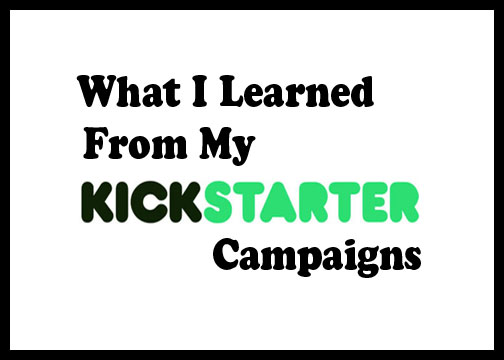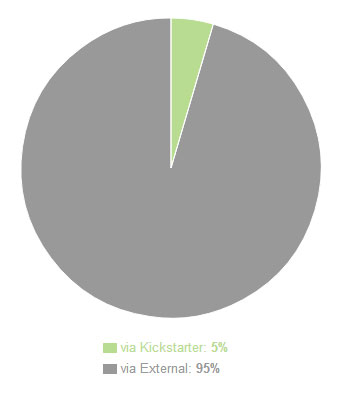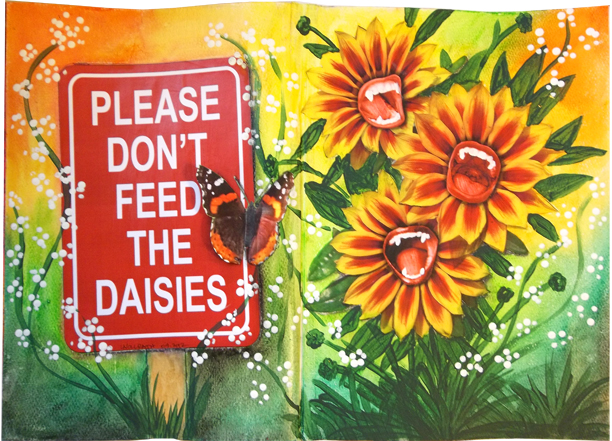Over the course of 2013 and 2014, I ran three successful Kickstarter campaigns: two for issues of a ‘zine I publish, and one for a collaborative art project. Along the way, I made a lot of mistakes, but I also learned a great deal about how Kickstarter works, and how to reach the goal of a successfully funded campaign.

Do Your Research Before You Launch
Before you launch a campaign, start with a little research. Do a search on your topic, and scroll through projects that are in the category in which your campaign will be included. Find projects that are fully funded, or close to reaching their funding goals.
- Read their project descriptions, and watch their videos. Make notes on what works for you, and what doesn’t. Use this information to help plan your own campaign story and video.
- Look through their rewards, and make note of any basic ideas that might also work for your campaign.
- Look at any public updates they’ve posted, to get ideas for what type of materials you might send out to your backers once your campaign starts running.
Start With a Short Video
According to Kickstarter, projects with videos are more likely to succeed than those without them.
- You don’t have to make a slick, polished video. Do the best you can with the equipment you have. Some of the most effective campaign videos are simply the creator sitting in front of a bookcase, talking about their project.
- Tell your story in simple, direct terms. Don’t get bogged down in a lot of fiddly details. Tell viewers what they need to know, and use the text section of your project to elaborate.
- Keep it short and sweet. Say what you need to say in three minutes or less.
- Remember to smile, and thank viewers for watching at the end of your video.
Tell a Great Story
Use the text portion of your project page to tell the story of your project. A few things to include in your project page:
- Tell people why you’re raising money, and where it will go once it’s raised.
- Keep your text well organized. Break it up in small chunks, with relevant titles.
- Show images of reward items, and describe them.
Offer a Variety of Rewards
When it comes to rewards, the key is to let people give you as much as they want. That means having reward tiers that start at $1, and go up to $1,000 or more, with plenty of options in between.
It helps to start by developing a list of digital or intangible rewards that can be offered at lower levels. Rewards like a mention on a Facebook page or web site, or a thank you in a publication give low bidders something that doesn’t cost you anything but a few minutes of time. Digital goods, like a .pdf copy of a publication, a screensaver, or a download may take a bit more time to pull together, but are easy to deliver, and don’t require postage.
I like to create a spreadsheet, and build rewards from bottom to top, adding on to each level to build the next one:
| Pledge Amount | Reward |
| $1 | Access to backer updates, and my eternal thanks. |
| $5 | A thank you on the project web site, access to backer updates, and my eternal thanks. |
| $10 | A postcard with a thank you message, a thank you on the project web site, access to backer updates, and my eternal thanks. |
Remember to use the same terminology as you build. For example, don’t say you’re sending a postcard in one reward, and call the same thing a postcard print or personal message in another.
I also prefer to list everything in each tier, rather than adding “and everything in the previous tier” or similar language. If someone is thinking of pledging $1,000, I want them to see the long list of things they’re getting, without having to scroll up and decipher exactly what that list includes.
Don’t Forget About Shipping
If you’re offering physical goods as rewards, you have to pay shipping costs. Remember to add those in when you’re figuring out your reward levels. Don’t offer something that costs you $10 to produce as a $10 reward if it costs $3 to ship it, or you’ll be losing money.
Creating a Campaign is Just the Start
Many people approach Kickstarter like A Field of Dreams: if you build it, they will come. Let me assure you, this is not the case. If you build a Kickstarter campaign, backers will not just magically appear on your doorstep. Building a campaign is just the first step in raising funds. You really have to go out and beat the bushes to find your backers. Be prepared to spend a little bit of time promoting your campaign each day of your funding period.
Don’t Rely on Kickstarter
 Very few of your backers will actually come from Kickstarter. In the three campaigns I’ve done so far, only 5% of my pledges have come from Kickstarter searches or on site links. The rest have come from off site links on Facebook, Twitter, and my email newsletter.
Very few of your backers will actually come from Kickstarter. In the three campaigns I’ve done so far, only 5% of my pledges have come from Kickstarter searches or on site links. The rest have come from off site links on Facebook, Twitter, and my email newsletter.
- Use your social media accounts to help spread the word. Post a link to your campaign on your Facebook and Twitter accounts as soon as you launch. Pin your campaign to a relevant Pinterest board. Take a screenshot of your project, and post it on Instagram.
- Don’t overdo the requests for help. One post on each social media account per week is sufficient. Be pleasant, and ask your followers to help spread the word. Include an update on your progress, but don’t beg or sound desperate.
- If you’re lucky enough to have an email list, or you send out a regular email newsletter, promote your project to those followers as well. Again, once a week, or once every 10 days is sufficient. Remember to ask for help in spreading the word.
- Ask your backers for help in spreading the word about your campaign, by sharing the project link on Facebook and Twitter. They already like your project enough to back it, so they will often be your biggest cheerleaders. Don’t hammer them with requests for help, but do include one whenever you send out a project update during the funding period.
Talk To Your Backers
Your backers expect to hear from you. Kickstarter provides a tool to update backers. If you don’t post something every few weeks in that period between the time the project is funded, and when the rewards go out, you will get emails. Be sure to update regularly, even if it’s just to give a progress report on how production is going. Plan on sending out a short message each time something significant occurs. Photos of boxes of the reward items arriving, or being packed to ship out are reassuring to your backers, and also sort of fun.
What You Raise is Not What You Get
Kickstarter takes 5% off the top of any money your campaign raises. If you’re in the US, your payments will be collected by Amazon Payments, which also takes roughly 5%. That’s 10% of the money you raise that you won’t ever see.
In addition, there will be people who pledge to your campaign, but don’t follow through with payment. In each of my small campaigns, there was at least one person whose payment didn’t clear by the deadline, and didn’t respond to email prompts to complete their payment.
If you need $1,000 in financing to make your idea a reality, you should set your campaign goal at least 15% higher, to cover the cost of fees and losses.




